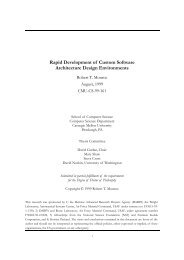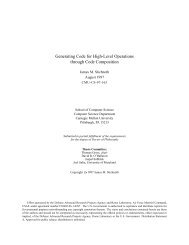Planning under Uncertainty in Dynamic Domains - Carnegie Mellon ...
Planning under Uncertainty in Dynamic Domains - Carnegie Mellon ...
Planning under Uncertainty in Dynamic Domains - Carnegie Mellon ...
Create successful ePaper yourself
Turn your PDF publications into a flip-book with our unique Google optimized e-Paper software.
3.1. Overview of prodigy 4.0 21associated with each variable <strong>in</strong> the operator's preconditions. The object's type mustmatch the variable's type and the set of objects must agree with all the functionsused <strong>in</strong> the variable specications. The <strong>in</strong>stantiated operator is applicable <strong>in</strong> a stateif the literal made from its preconditions statement is true <strong>in</strong> that state.If an <strong>in</strong>stantiated operator is applied to a state, a new state is produced correspond<strong>in</strong>gto the result of apply<strong>in</strong>g the operator <strong>in</strong> the orig<strong>in</strong>al state. The new stateis specied as follows. First, the test correspond<strong>in</strong>g to each conditional eect set isevaluated <strong>in</strong> the state. If it is true, the correspond<strong>in</strong>g conditional eects are treatedas regular eects, otherwise they are discarded. Next the literals mentioned <strong>in</strong> eachadd or del statement are exam<strong>in</strong>ed for variables, and any variables mentioned <strong>in</strong> thepreconditions slot are replaced with their object values from the <strong>in</strong>stantiation of theoperator. If there are variables that are not mentioned <strong>in</strong> the preconditions slot, theyare treated as universally quantied. For each such variable, a variable specicationmust be given <strong>in</strong> the eects slot, mention<strong>in</strong>g a type and optionally some b<strong>in</strong>d<strong>in</strong>gsfunctions <strong>in</strong> the same way as <strong>in</strong> the preconditions slot. Each literal <strong>in</strong> the eects thatmentions one of these variables is replaced with a set of literals, correspond<strong>in</strong>g toevery object <strong>in</strong> the plann<strong>in</strong>g problem that matches the variable specication. Afterthe literals <strong>in</strong> the eects are all translated <strong>in</strong>to one or more literals that mentionno variables, the state transformation is made. First the literals mentioned <strong>in</strong> delstatements are made false <strong>in</strong> the state. Next the literals mentioned <strong>in</strong> add statementsare made true <strong>in</strong> the state. Any literal that is not mentioned <strong>in</strong> the eects of the<strong>in</strong>stantiated operator has the same truth value <strong>in</strong> the new state as <strong>in</strong> the old state.For example, suppose a plann<strong>in</strong>g problem uses a doma<strong>in</strong> that <strong>in</strong>cludes the Move-Bargeoperator as shown, and <strong>in</strong>cludes the objects barge1 of type Barge and Richmond andOakland of type Place. If the <strong>in</strong>itial state has the true literal (at barge1 Richmond),then the <strong>in</strong>stantiated operator(Move-Barge =barge1 =Richmond =Oakland)will be applicable <strong>in</strong> the <strong>in</strong>itial state. Apply<strong>in</strong>g it would lead to a new state, <strong>in</strong> which(at barge1 Richmond) would be false and (at barge1 Oakland) would be true,with all other literals unchanged.A plan <strong>in</strong> prodigy 4.0 is a totally-ordered sequence of <strong>in</strong>stantiated operators(O 1 ;O 2 ;...O n ). The plan can be re-formulated <strong>in</strong> a partial order after creation ifdesired [Veloso 1992]. I will refer to an <strong>in</strong>stantiated operator <strong>in</strong> a plan as a step <strong>in</strong>the plan. A plan is a solution to the plann<strong>in</strong>g problem if:1. O 1 is applicable <strong>in</strong> the <strong>in</strong>itial state and apply<strong>in</strong>g it leads to the state S 1 ,2. each step O i for 2 i n is applicable <strong>in</strong> the state S i,1 and apply<strong>in</strong>g it leadsto the state S i and3. the goal description is satised <strong>in</strong> state S n .For example, given the <strong>in</strong>itial state above and the goal (at barge1 Oakland), theplan consist<strong>in</strong>g of the s<strong>in</strong>gle step (Move-Barge =barge1 =Richmond=Oakland) is a solution for this plann<strong>in</strong>g problem.







